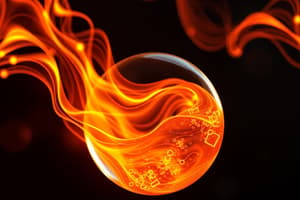Podcast
Questions and Answers
Flashcards
Gravity
Gravity
A fundamental interaction that causes objects with mass to attract each other.
Mass
Mass
The amount of matter in an object. The larger the mass, the stronger the gravitational pull.
Black hole
Black hole
A region of spacetime where gravity is so strong that nothing, not even light, can escape.
Conduction
Conduction
Signup and view all the flashcards
Convection
Convection
Signup and view all the flashcards
Radiation
Radiation
Signup and view all the flashcards
Conductors
Conductors
Signup and view all the flashcards
Insulators
Insulators
Signup and view all the flashcards
Static Electricity
Static Electricity
Signup and view all the flashcards
Current Electricity
Current Electricity
Signup and view all the flashcards
Electric Charge
Electric Charge
Signup and view all the flashcards
Newton's Law of Universal Gravitation
Newton's Law of Universal Gravitation
Signup and view all the flashcards
Einstein's Theory of Relativity
Einstein's Theory of Relativity
Signup and view all the flashcards
Conduction vs Convection
Conduction vs Convection
Signup and view all the flashcards
Current vs Static Electricity
Current vs Static Electricity
Signup and view all the flashcards
Study Notes
Physics
- Physics studies matter, its motion, and how it interacts with energy and forces.
- Branches include electricity, astronomy, motion, waves, sound, and light.
- Physics studies elementary particles, atoms, and the universe.
Gravity
- Gravity is a fundamental interaction causing mutual attraction between objects with mass or energy.
- All objects have gravity, but some, like Earth and Sun, have significantly more.
- Gravity depends on mass (size) and distance.
- The Sun's gravity keeps Earth in orbit.
- Gravity was mathematically described by Newton (Newton's law of universal gravitation).
- Einstein improved this theory with his theory of relativity.
Heat Transfer
- Heat transfer is the exchange of thermal energy between systems.
- Modes include conduction (direct contact), convection (medium movement), and radiation (waves).
- Conductors allow heat to travel easily (metals).
- Insulators resist heat transfer (non-metals like plastic, clay, wood).
- Convection occurs in liquids and gases, while radiation transfers heat through space. Examples include electric heaters.
Electricity
- Electricity is a type of energy that can build up (static) or flow (current).
- Static electricity builds up when objects are rubbed together (e.g., balloon and jumper).
- Current electricity moves from one place to another, powering devices.
- Lightning is a significant example of current electricity.
Studying That Suits You
Use AI to generate personalized quizzes and flashcards to suit your learning preferences.




